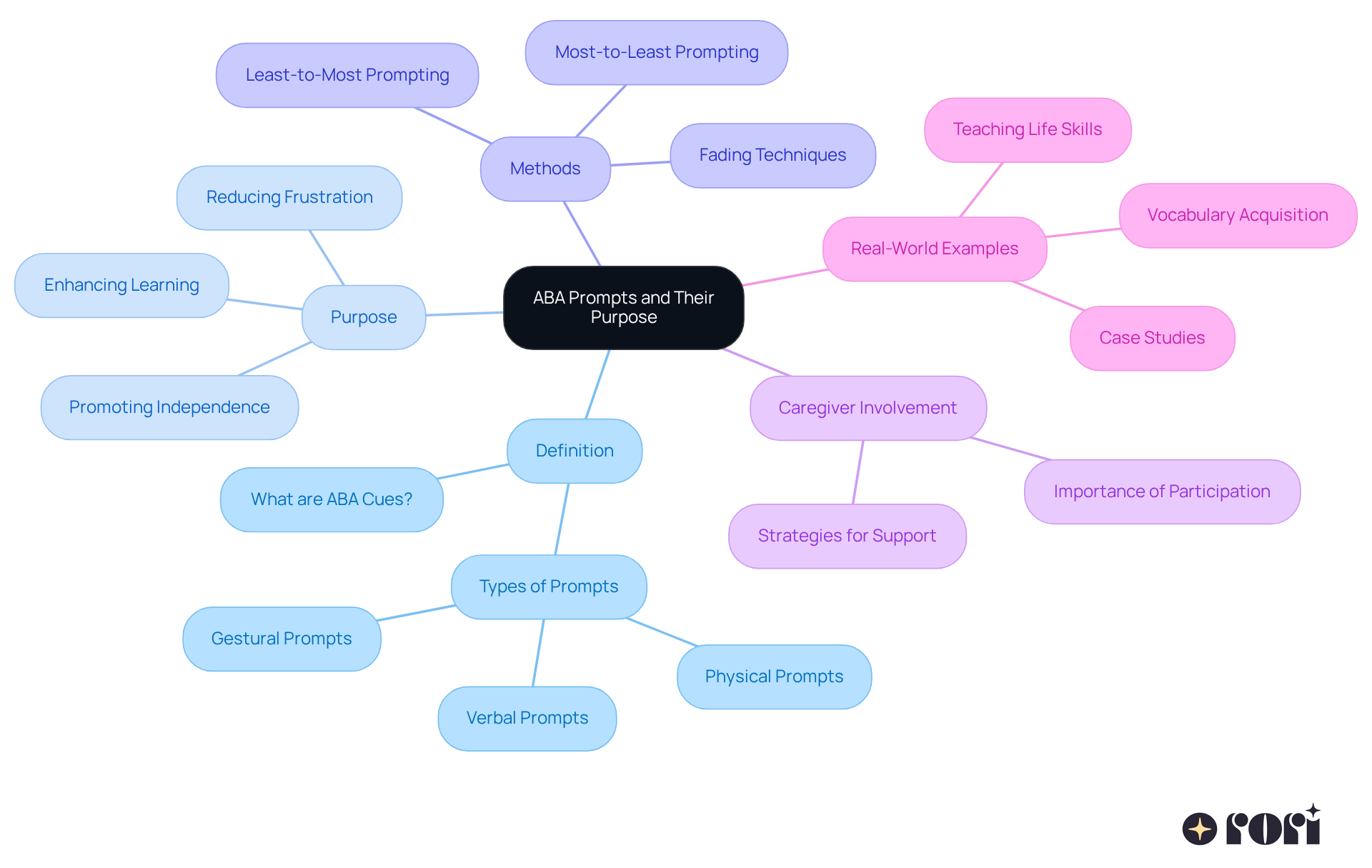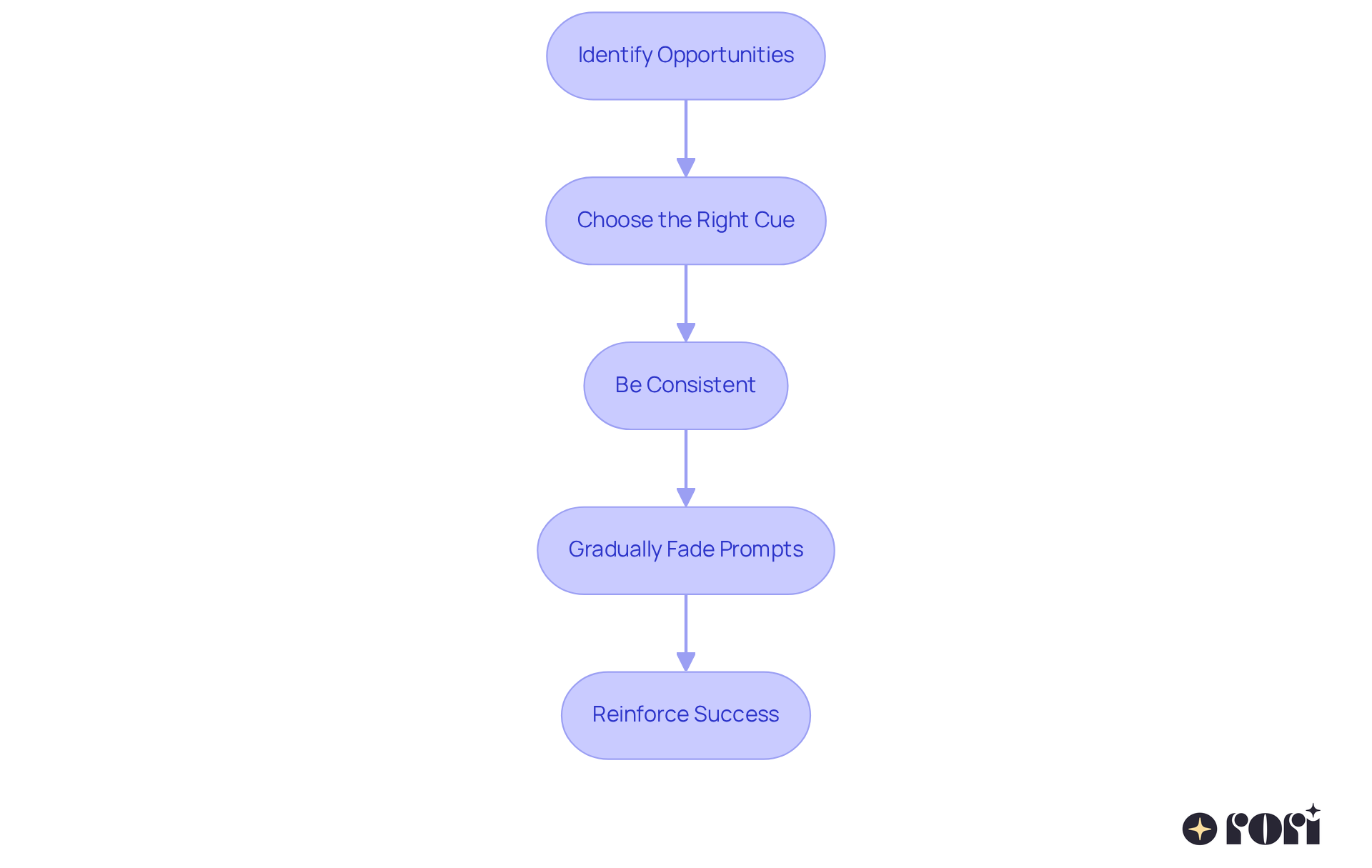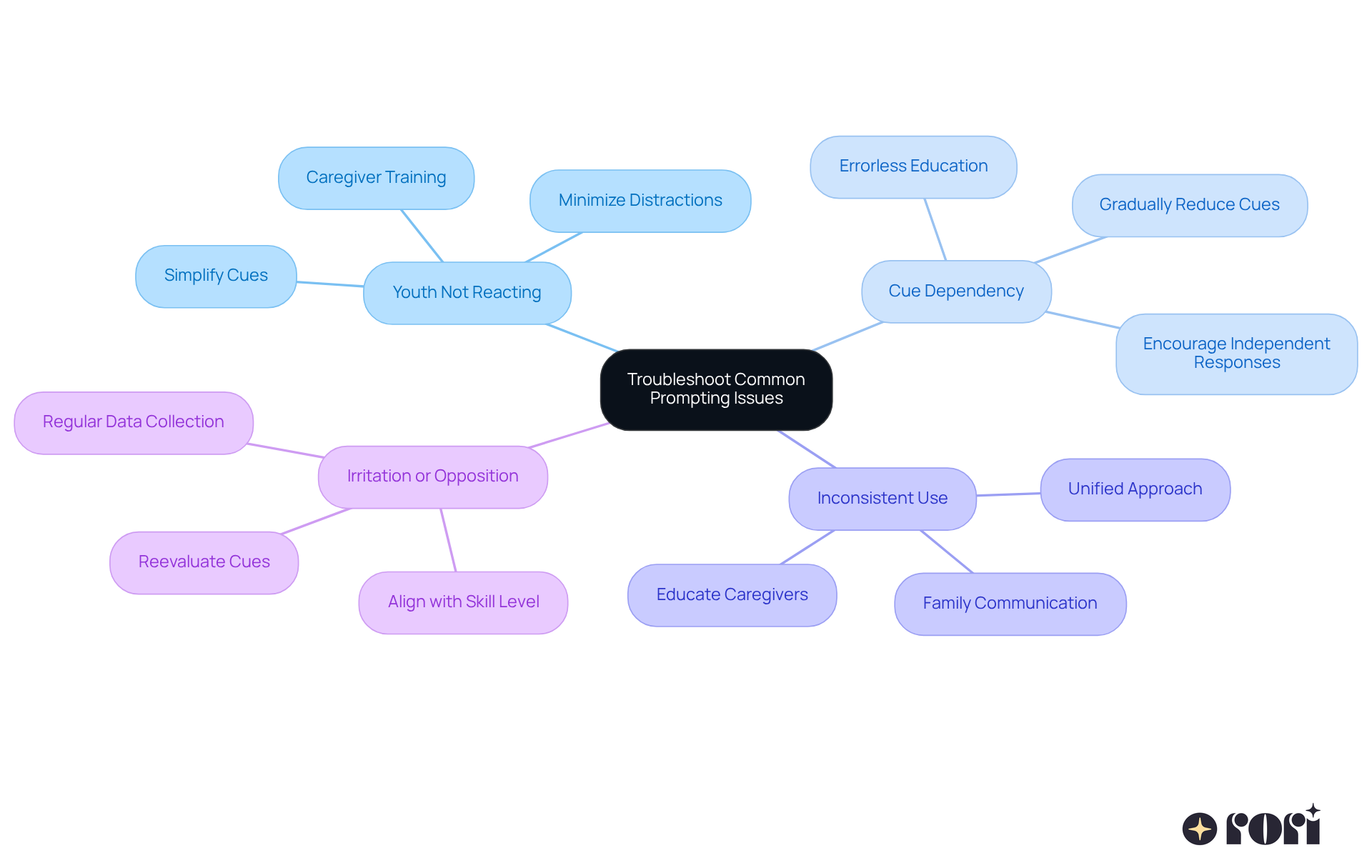The article "Master ABA Prompts: A Step-by-Step Guide for Parents" is all about helping parents effectively use Applied Behavior Analysis (ABA) prompts to support their children's learning and independence. It highlights the various types of prompts—like verbal, gestural, and modeling—and shares practical strategies for implementation. Consistency and gradually fading assistance are key points, backed by research showing that active caregiver involvement can really boost learning outcomes for children with autism.
Navigating the world of ABA can feel overwhelming at times, but you’re not alone! Many parents face similar challenges, and understanding how to use prompts effectively can make a world of difference. Imagine sitting down with your child, using a simple gesture to guide them, and watching as they start to learn and grow. Isn’t that a wonderful thought?
As you dive into this guide, remember that every little step counts. By incorporating these prompts into your routine, you’re not just teaching your child; you’re also building their confidence and independence. So, let’s explore this together! We’re here to help you every step of the way!
Navigating the complexities of guiding children through learning can feel overwhelming for parents. It's especially true when it comes to implementing techniques like Applied Behavior Analysis (ABA) prompts. These prompts are vital tools that help bridge the gap between instruction and the desired behaviors, promoting independence and skill mastery in children.
But as parents embark on this journey, they often find themselves asking important questions:
This guide is here to explore the nuances of ABA prompts, offering practical insights and solutions to empower you in your essential role. Let’s explore this together!
ABA cues are vital indicators or signals designed to encourage specific behaviors or responses from youngsters. They serve as a bridge between instruction and the desired behavior, helping kids understand what’s expected of them. The main aim of ABA cues is to enhance education by providing clear direction, which significantly boosts the chances of a successful response. For instance, when teaching a child to greet others, a parent might say, 'What do you say when you see someone?' This simple advice helps the child connect the situation with the right reaction, enriching their learning journey.
Research shows that personalized prompting techniques, like most-to-least and least-to-most methods, can lead to better learning outcomes and increased confidence in individuals with autism. In fact, studies indicate that around 90% of young individuals see significant progress when recommended therapy hours are fully utilized with active caregiver involvement. This underscores the importance of caregiver participation in the ABA process, as it creates a nurturing environment that supports children's growth and aligns with the individualized plans crafted by qualified behavior analysts, which include measurable goals and evidence-based strategies.
Behavioral therapists emphasize the effectiveness of ABA cues in promoting independence. For example, Jenna Garvey, a Clinical Director at the May Center School for Autism and Developmental Disabilities, notes that while cues are helpful, they should be gradually reduced to encourage learners to complete tasks on their own. This gradual decrease in support not only fosters independence but also aligns with the principles of the immediate hierarchy, which is essential for skill acquisition.
Real-world examples further illustrate the impact of ABA cues. In a case study focused on teaching life skills, physical cues were used to help a young person wash dishes, starting with full support and slowly tapering down to a gentle touch. This approach proved effective in promoting independence while ensuring the child learned the necessary skills. Similarly, gestural signals, like pointing to objects, have been shown to aid in vocabulary acquisition, providing non-verbal cues that enhance understanding without relying solely on verbal instructions.
Overall, the use of the aba prompt plays a crucial role in supporting the development and behavior of youth, making it a key component of effective autism therapy. Adjusting the level of assistance based on the child's performance is vital to maintain interest and prevent dependence on cues, ensuring that children can develop skills independently while caregivers are equipped with the knowledge and strategies to support their child's behavioral goals. Let’s explore this together!

ABA therapy incorporates a variety of aba prompts to make learning easier and more engaging for young ones, with each prompt serving its own special role. Let’s dive into the main types:
By recognizing and using these different types of cues, parents can implement an aba prompt to choose the best techniques tailored to their child's unique learning style. This not only makes the therapy more effective but also more enjoyable for everyone involved.
It’s important for parents to keep an eye on their child’s progress in ABA therapy, especially for those with ADHD. This helps in evaluating how well the cues are working. Active involvement from caregivers is essential; it enhances support at home and aligns with therapeutic strategies, leading to better behavioral outcomes.
Understanding the concept of fading assistance is also key. This means gradually reducing support, which encourages independence and lessens reliance on cues.
Additionally, treatment plans are adjusted based on progress reports, ensuring that the strategies remain effective and tailored to the child’s evolving needs. Consulting with BCBAs can provide valuable insights on selecting the right cues for each individual, ensuring a balanced approach to their therapy.
Let’s explore this together! We’re here to help you every step of the way!

To effectively implement ABA prompts in your daily routines, let’s explore these steps together:
Identify Opportunities: Keep an eye out for those moments in your day where prompting can really make a difference—think mealtime, playtime, or getting dressed. Understanding what happens before a behavior helps you spot those triggers, allowing you to step in just at the right time.
Choose the Right Cue: Depending on what your little one needs, pick the most suitable type of cue—whether it's verbal, gestural, or something else. Verbal cues can be especially effective for kids who have already mastered skills through physical or modeling techniques.
Be Consistent: Consistency is key! Using the same aba prompt over and over helps your child learn what’s expected of them. This consistency strengthens their learning, making it easier for them to generalize those skills in different settings.
Gradually Fade Prompts: As your child grows more independent, start to reduce the level of prompting you use. For example, if you initially used a verbal cue, try switching to a gestural signal, and eventually aim to provide no assistance at all. This approach supports 'errorless learning' strategies, which can minimize frustration and boost skill acquisition using an aba prompt.
Reinforce Success: Celebrate those moments when your child responds well to cues! Use praise or rewards to motivate them to keep using the learned behavior. Positive reinforcement is a cornerstone of ABA therapy, increasing the chances of those desired behaviors being repeated.
By weaving these strategies into your daily activities, you can create a supportive environment that nurtures independence and skill development. We’re here to help you every step of the way!

Common prompting issues may include:
Youth Not Reacting: If your child isn’t responding to cues, take a moment to assess how complex the cue is and how distracted they might be. Simplifying your request or minimizing distractions in their environment can really help boost their responsiveness. Research shows that effective aba prompt strategies can lead to increased confidence and skill mastery in learners. It’s also crucial that caregivers receive training—knowledgeable caregivers can better understand how to adjust cues to fit their child’s needs, leading to improved behavioral outcomes.
Cue Dependency: To tackle cue dependency, try gradually reducing the cues you provide. Start with less intrusive prompts and encourage your child to respond independently, fostering their self-reliance in learning. As Dube notes, "The overarching goal is errorless education, which minimizes mistakes and builds self-efficacy." When caregivers are empowered with the ABA prompt principles, they can implement these strategies effectively, reducing stress and boosting their confidence.
Inconsistent Use: Consistency is key! It’s essential that everyone in the family is on the same page about using prompts. Open conversations about strategies can help maintain a unified approach, reinforcing your child’s learning. Dube emphasizes that "Consistent practice at home, aligned with therapy goals, enhances skill learning and generalization." Educating caregivers plays a big role in achieving this consistency, enabling them to make informed choices that positively impact their child's progress.
Irritation or Opposition: If your child seems frustrated, it might be time to reevaluate the cues you’re using. Adjust them to better align with their current skill level—making sure they’re not too difficult or too easy. Regularly collecting data can help you pinpoint the right moment to reduce prompts based on your child’s progress. Active participation from caregivers, supported by education, can lead to better behavioral outcomes and a more effective learning environment.
By proactively addressing these common issues, you can create a more effective learning environment for your child, ultimately enhancing their progress in the aba prompt therapy. Let’s explore this together!

As we wrap up, mastering ABA prompts is truly essential for parents looking to boost their child's learning and independence. These prompts are like guiding stars, helping children move towards desired behaviors and making the learning journey both effective and engaging. By grasping their purpose and how to implement them, parents can create a nurturing environment that supports skill acquisition while also building confidence and self-reliance.
Throughout this article, we've shared valuable insights into the different types of ABA prompts—verbal, gestural, modeling, physical, and visual cues. Each type has its own unique role in helping children navigate their learning experiences. We can't stress enough the importance of caregiver involvement; consistent and tailored prompting strategies can significantly enhance behavioral outcomes. Plus, we discussed practical steps for weaving prompts into daily routines and troubleshooting common challenges, giving parents actionable guidance to support their journey.
Incorporating ABA prompts into everyday life isn't just about teaching specific skills; it's about empowering children to thrive independently. By actively engaging in their child's learning journey and adapting strategies as needed, parents can make a profound impact on their child's development. Embracing these techniques not only benefits the child but also strengthens the parent-child bond, creating a supportive atmosphere that celebrates growth and achievement.
Let’s explore this together! Remember, we’re here to help you every step of the way!
What are ABA prompts and their purpose?
ABA prompts are cues designed to encourage specific behaviors or responses in children. They serve as a bridge between instruction and the desired behavior, helping kids understand what is expected of them and enhancing education by providing clear direction.
How do ABA prompts enhance learning for children with autism?
Personalized prompting techniques, such as most-to-least and least-to-most methods, lead to better learning outcomes and increased confidence in individuals with autism. Research shows that about 90% of young individuals make significant progress when recommended therapy hours are fully utilized with active caregiver involvement.
Why is caregiver participation important in the ABA process?
Caregiver participation is crucial as it creates a nurturing environment that supports children's growth. It aligns with individualized plans crafted by qualified behavior analysts, which include measurable goals and evidence-based strategies.
How do ABA cues promote independence in learners?
ABA cues are effective in promoting independence by gradually reducing support as learners become more capable of completing tasks on their own. This aligns with the principles of the immediate hierarchy, which is essential for skill acquisition.
Can you provide examples of how ABA cues are used in practice?
In a case study teaching life skills, physical cues were used to help a child wash dishes, starting with full support and gradually reducing to a gentle touch. Additionally, gestural signals, like pointing to objects, have been effective in aiding vocabulary acquisition by providing non-verbal cues.
What is the significance of adjusting the level of assistance in ABA prompting?
Adjusting the level of assistance based on the child's performance is vital to maintain interest and prevent dependence on cues. This ensures that children can develop skills independently while caregivers are equipped with the knowledge and strategies to support their child's behavioral goals.